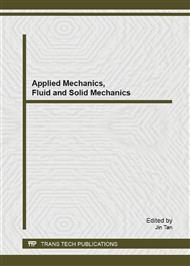p.164
p.171
p.179
p.184
p.189
p.194
p.200
p.206
p.211
Effects of Oil Palm Empty Fruit Bunch (OPEFB) Fibre Size on Fracture Toughness of OPEFB Filled Polymer Nanocomposite
Abstract:
The effect of oil palm empty fruit bunch (OPEFB) fiber size on the fracture toughness of OPEFB/PP/PPnanoclay composites was investigated. Four fiber sizes ranging from 180 μm, 250 μm, 300 μm, and 355 μm were used to reinforce PP/PPnanoclay composites. The ratio of PP/PPnanoclay was 7:100 by weight (7 phr). Fracture toughness of the composite was determined according to ASTM D5045 and single edge notch bending (SENB) been employed during the test. The result indicates that the fracture toughness of OPEFB/PP/PPnanoclay composites has decreased as OPEFB fiber size increased. Fracture surfaces investigated through the scanning electron microscopy (SEM) showed that the bonding between fiber and matrix for OPEFB/PP/PPnanoclay composites with smaller OPEFB fibre size has better bonding as compared to OPEFB/PP/PPnanoclay composites with larger OPEFB fiber size.
Info:
Periodical:
Pages:
189-193
Citation:
Online since:
December 2013
Price:
Сopyright:
© 2014 Trans Tech Publications Ltd. All Rights Reserved
Share:
Citation:


